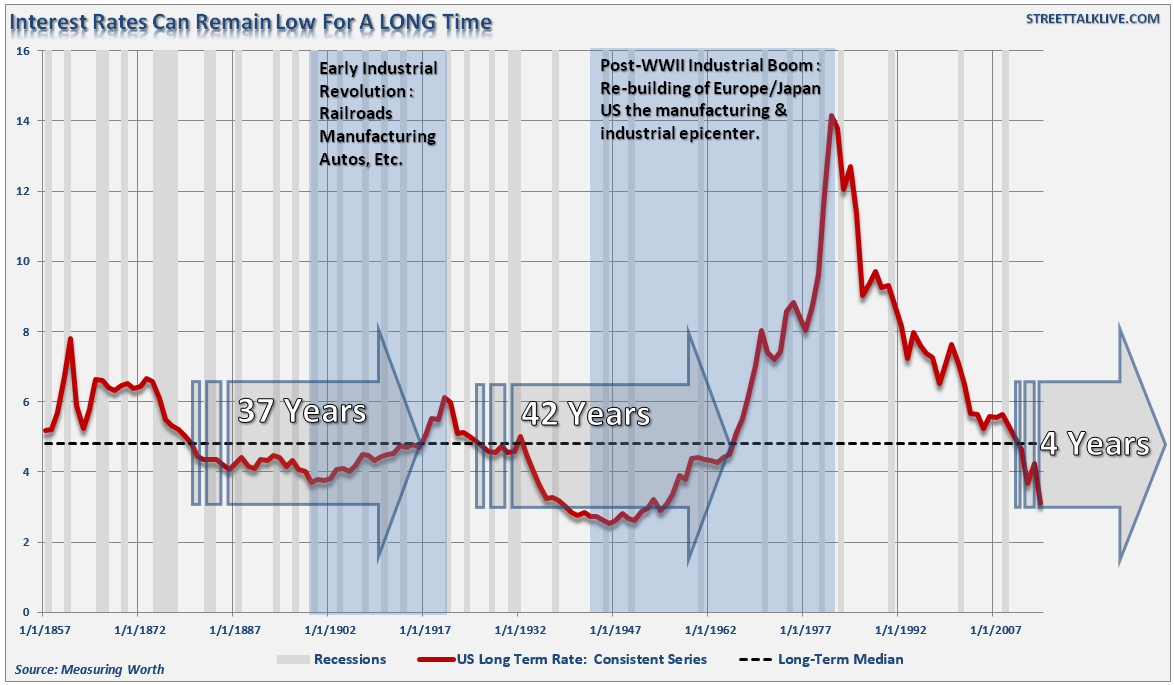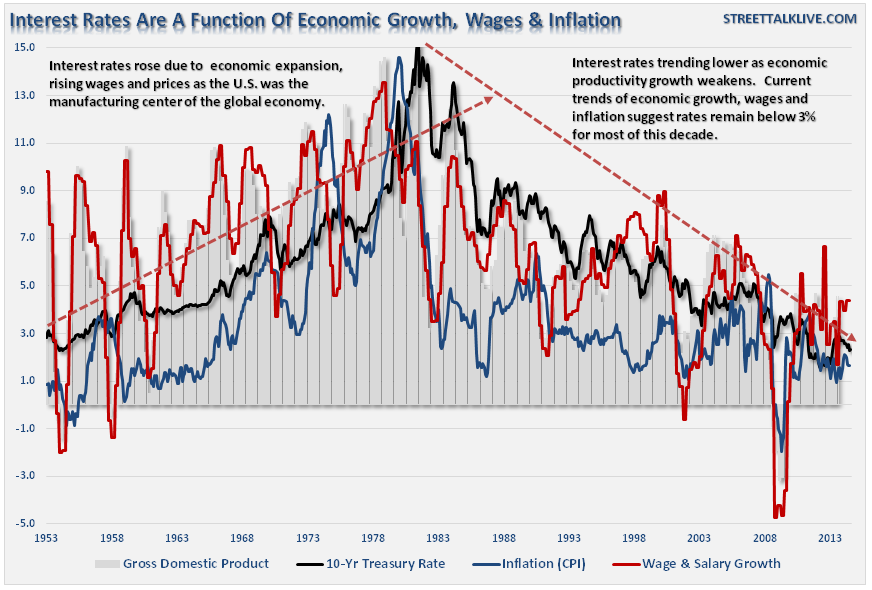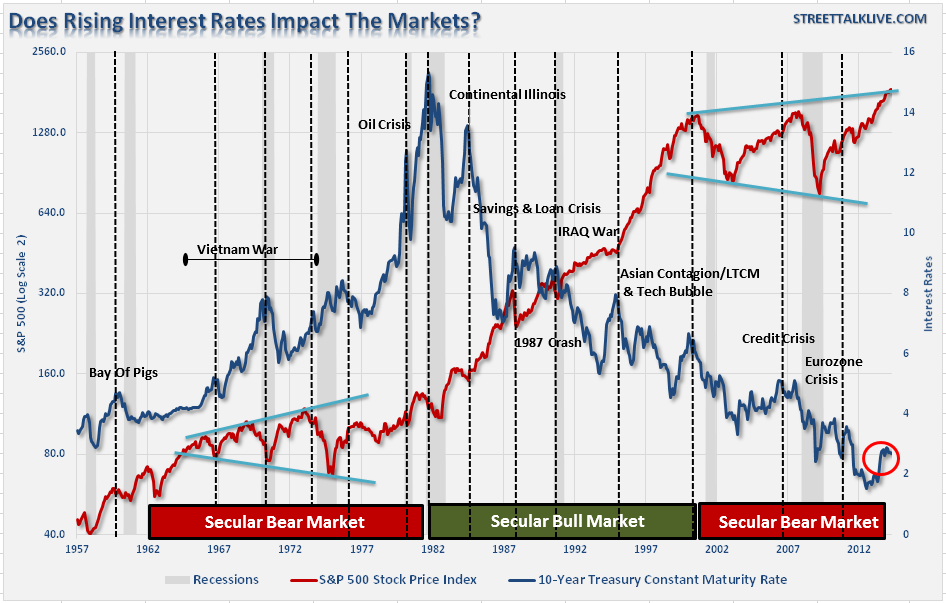Earlier this week Daniel Druger and Liz McCormick wrote an article for Bloomberg entitled: One Hundred Years Of Bond History Means Bears Destined To Lose. The crux of the article is contained within the following paragraph:
"With the longest-dated Treasuries now yielding less than half the 6.8 percent average over the past five decades, it’s not hard to see why forecasters say they’re bound to rise as the Federal Reserve prepares to raise interest rates following the most aggressive stimulus measures in its 100-year history."
The premise here is simple. With interest rates near their lowest levels on record, they have nowhere to go from here "but up." This is the consensus of virtually all of the analysts and economists on Wall Street which currently suggests that rates will rise to 3.88% next year on the 30-year treasury.
That was also the belief in June of 2013 when rates did spike on an emerging market bond rout. The majority of the mainstream media and guru's like Bill Gross, claimed that the "bond bull market" was dead. At the time, I suggested they would be quite wrong stating:
"For all of these reasons I am bullish on the bond market through the end of this year. Furthermore, with market volatility rising, economic weakness creeping in and plenty of catalysts to send stocks lower - bonds will continue to hedge long only portfolios against meaningful market declines while providing an income stream."
Since then rates have continued to be in a steady decline as real economic strength has remained close to 2% annually, deflationary pressures have risen and monetary velocity has fallen. The chart below is a history of long-term interest rates going back to 1857. The dashed black line is the median interest rate during the entire period.
Interest rates are a function of strong, organic, economic growth that leads to a rising demand for capital over time. There have been two previous periods in history that have had the necessary ingredients to support rising interest rates. The first was during the turn of the previous century as the Rockefeller's, Carnegie's, Mellon's, Vanderbilt's and others wrestled for control of the American economy. Empires in rail, tobacco, steel and trade were built on the backs of human misery as economic output flourished.
The second period occurred post-World War II as America became the "last man standing" as France, England, Russia, Germany, Poland, Japan and others were left devastated. It was here that America found its strongest run of economic growth in it history as the "boys of war" returned home to start rebuilding the countries that they had just destroyed. But that was just the start of it.
Beginning in the late 50's, America embarked upon its greatest quest in history as man took the first steps into space. The space race that lasted nearly twenty years led to leaps in innovation and technology that paved the wave for the future of America. Combined with the industrial and manufacturing backdrop, America experienced high levels of economic growth and increased savings rates, which fostered the required backdrop for higher interest rates.
Currently, the U.S. is no longer the manufacturing powerhouse it once was and globalization has sent jobs to the cheapest sources of labor. Technological advances continue to reduce the need for human labor and suppress wages as productivity increases. Today, the number of workers between the ages of 16 and 54 is at the lowest level relative to that age group since 1976. As discussed recently, this is a structural problem that continues to drag on economic growth as nearly 1/4th of the American population is now dependent on some form of governmental assistance.
Is Everyone Still Wrong?
This structural employment problem remains the primary driver as to why "everybody" is still wrong in expecting rates to rise. As I addressed previously in Interest Rate Predictions Meet Rule #9:
"As you can see there is a very high correlation, not surprisingly, between these three components (inflation, economic and wage growth) and the level of interest rates. Interest rates are not just a function of the investment market, but rather the level of "demand" for capital in the economy. When the economy is expanding organically, the demand for capital rises as businesses expand production to meet rising demand. Increased production leads to higher wages which in turn fosters more aggregate demand. As consumption increases, so does the ability for producers to charge higher prices (inflation) and for lenders to increase borrowing costs.
However, in the current economic environment this is not the case. The need for capital remains low, outside of what is needed to absorb incremental demand increases caused by population growth, as demand remains weak. While employment has increased since the recessionary lows, much of that increase has been the absorption of increased population levels. Many of those jobs remain centered in lower wage paying and temporary jobs which does not foster higher levels of consumption."
Currently, there are few economic tailwinds prevalent that could sustain a move higher in interest rates. The reason is the higher interest reduces the flow of capital within the economy. For an economy that remains dependent on the generosity of Central Bankers, rising rates are not the outcome that "stock market bulls" want.
The chart and table below show what happens to the financial markets and the economy, when interest rates increase.
The problem with most of the forecasts for the end of the bond bubble is the assumption that we are only talking about the isolated case of a shifting of asset classes between stocks and bonds. However, the issue of rising borrowing costs spreads through the entire financial ecosystem like a virus. The rise and fall of stock prices has very little to do with the average American and their participation in the domestic economy. Interest rates, however, are an entirely different matter.
While there is not much downside left for interest rates to fall in the current environment, there is also not a tremendous amount of room for increases. Since interest rates affects "payments," increases in rates quickly have negative impacts on consumption, housing and investment.
This idea suggests is that there is one other possibility that the majority of analysts and economists ignore, which I call the "Japan Syndrome."
Japan is has been fighting many of the same issues for the past two decades. The "Japan Syndrome" suggests that while interest rates are near lows it is more likely a reflection of the real levels of economic growth, inflation and wages. If that is true, then rates are most likely "fairly valued", which implies that the U.S. could remain trapped within the current trading range for years as the economy continues to "muddle" along.
Will the "bond bull" market eventually come to an end? Yes, eventually. However, the catalysts needed to create the type of economic growth required to drive interest rates substantially higher, as we saw previous to the 1960-70's, are simply not available today. This will likely be the case for many years to come as the Fed, and the administration, come to the inevitable conclusion that we are now caught within a 'liquidity trap' along with the bulk of developed countries.





